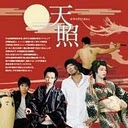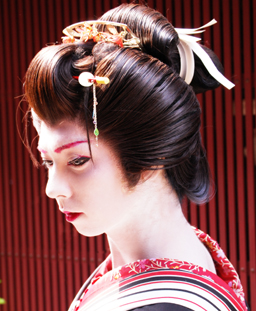Family crests first appeared in Japan during the Heian period when aristocrats placed their favorite designs of plants and flowers on clothes and cow carriages.
Warriors then began to use family crests with more geometric designs on their flags to identify themselves on the battlefields.
Though powerful merchants and kabuki actors were permitted to use them in the Edo period, ordinary people have been able to use family crests freely since the Meiji period.
There are said to be more than 10,000 different family crests in Japan.
Though I have a family crest, I have my own crest too as an artist. It is “Tachibana (mandarin orange)” which is auspicious motif in Japan.
Today, family crests can be seen on black ceremonial kimonos, called “montsuki.” This picture is the crest on the “montsuki.” which I wore in New Year’s show at Kagaya.
This is a combination of “Fuji (Japanese wisteria)” motif and “Mari (temari ball)” motif. Fuji motif is representing “Takafuji-ryu (the group of Japanese dance which I belong to) and “Mari (temari ball)” motif comes from the name of my grand master. Her name is Mariko. She is my mother. I use this motif to display a feeling of respect to her.In addition, there is my name ”Ukon(右近)” in it.
日本では家紋は、平安時代に貴族が好きな花や植物の文様を衣装や牛車に付けたのがはじまりです。やがて、武家が旗印として、戦 場で敵味方が見分けられるように幾何学的デザインを用いるようになりました。
場で敵味方が見分けられるように幾何学的デザインを用いるようになりました。
有力な町人や歌舞伎役者たちは、江戸時代にはすでに家紋を使っていましたが、一般人が自由に家紋を使うようになったのは明治時代からだそうです。日本には1万以上の家紋があるそうですよ。
この写真は加賀屋さんでのお正月のカウントダウンステージにて着用した紋付です。
紋は母親の流派 孝藤流の藤に鞠です。 なぜなら母が孝藤まりこ家元ですので紋に鞠をあしらっています。鞠に右近という字をいれさせてもらってます。







Leave a comment